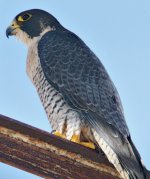Can anyone assist with age/sex of this bird perched on the FCC antenna array near the airport? It was observed today for 75 minutes on the pre-survey for the Christmas Bird Count on Sunday. Comments by the observers were that it, "felt less robust than the female observed last year". It showed very little distress to have three cars drive past and six people gawking at it talking and taking images. It is the second image "voucher-documented" Peregrine for the Park!
Attachments
Last edited:





